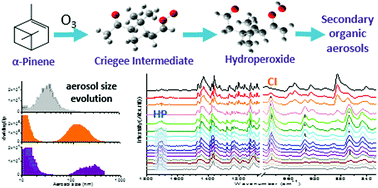Evidence and evolution of Criegee intermediates, hydroperoxides and secondary organic aerosols formed via ozonolysis of α-pinene†
Abstract
α-Pinene, the most abundant monoterpene in the atmosphere, accounts for more than 50% of global monoterpene emission. Though its reaction with ozone has been generally perceived as a major source of secondary organic aerosols (SOAs), direct evidence of its reaction intermediates (RI) and their evolution remain lacking. Here we study the ozonolysis of α-pinene between 180 and 298 K using a long-path, temperature-variable aerosol cooling chamber coupled to a rapid-scan time-resolved Fourier transform infrared spectrometer. The spectroscopic signatures of large Criegee intermediates (CIs) and hydroperoxides (HPs) were found for the first time. The aerosol size evolution during the reaction was also measured. In contrast to a previous perception, we show that temperature plays a determinant role in the ozonolysis kinetics. Finally, we show that the formation of HPs is an energetically favorable pathway to dissipate CIs. This study provides new insights into the ozonolysis of α-pinene and its contribution to SOA formation.



 Please wait while we load your content...
Please wait while we load your content...